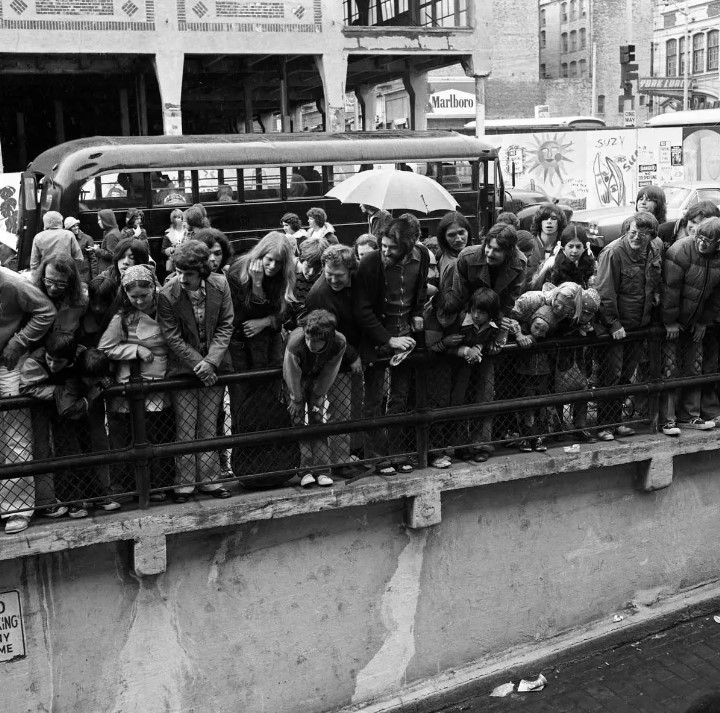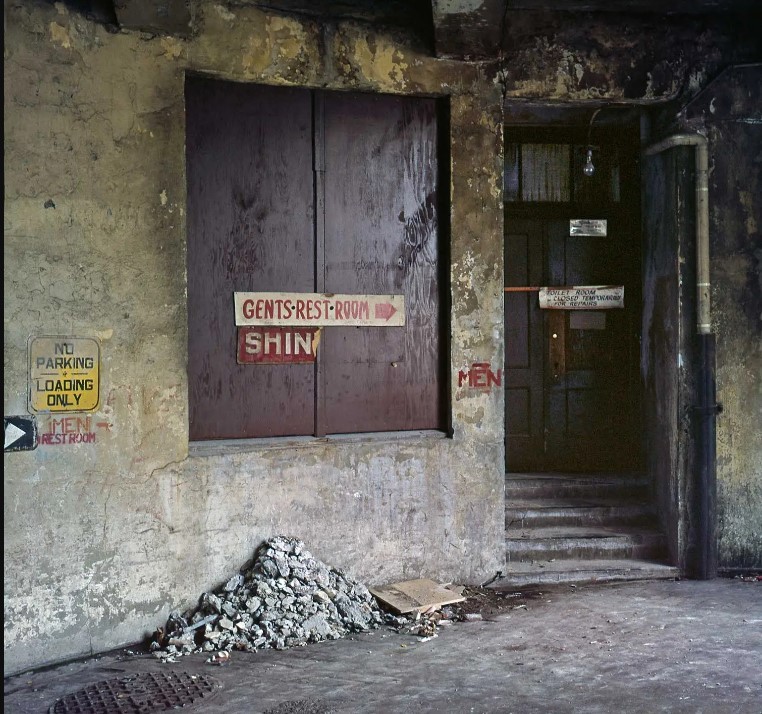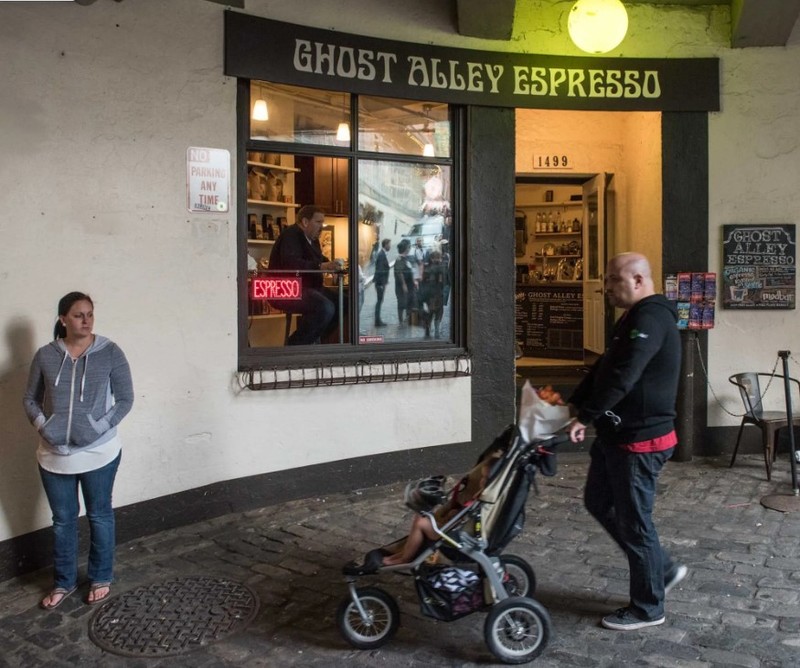The Gum Wall Alley
Introduction
Text-to-speech Audio
The crowded alley with colorful gum pieces plastered on the side beneath Pike Place Market was accidentally created. Located in Post Alley in the southern part of the market, the Gum Wall was started by the patrons of a theater back in 1993. The alleyway itself has served many different purposes since Pike Place’s opening. However, it did not always have a lighthearted, tourist-attracting history. Largely forgotten, the KKK and Chief Seattle’s eldest daughter are somehow also connected to the alleyway. However, the alleyway is now known because of the Gum Wall and the Ghost Alley Espresso Cafe. Seen as a quirkier version of the love locks in Italy and Paris, the Gum Wall today is a piece of contemporary history showing the vibrant side of Seattle.
Images
Spectators gather above to watch boxcar racers speed down Post Alley, 1975.

In the underground portion of Post Alley, the entrance to the “Gents Restroom,” Seattle’s first municipal restroom is closed with a boarded window and a red tape and a sign across the door, 1966.

Now, the restroom from 1966 is replaced with a coffee shop named Ghost Alley Espresso, which sells gum to visitors for the nearby Gum Wall in addition to coffees.

Backstory and Context
Text-to-speech Audio
In 1907, the ground level of Pike Place Market was raised to create a multi-level campus and the partially underground Post Alley, where the Gum Wall would later situate. Then, farmers selling fresh vegetables and goods congregated in the stalls daily. The Market was less the cultural, artsy, and restaurant-filled attraction of today than the place to buy the cheapest produce in town. The infrastructures, as a result, were also maintained minimally. Most of the time, Post Alley served as a pedestrian passageway, needing repair with its exposed cement walls and one or two windows and doors.
Over the century, Post Alley changed as Pike Place Market grew, sometimes serving as extra spaces for pedestrians and other times for entertainment. In 1908, the underground portion of Post Alley, where it curves to meet the stairway, was used as the male entrance to Seattle’s first municipal restroom. However, in 1966, the restroom finally closed, with too many places needing repairs. A sign that read, “Toilet room, closed temporarily for repairs,” was stretched across the door. In the 1970s, the alleyway, starting at the intersection of First Avenue and Pike Place, began to gather spectators. Soapbox races took place in the alley as people watched above. So, the entertainment era of Post Alley began. Small theater productions opened in Post Alley in the mid-1970s to 1990s. Still, the alley was not glamorous, and the storefronts looked more functional than attractive.
Post Alley might have been described as “dingy” and slightly ghostly by some with its exposed walls and dark passageway. This description would not have been far-off for parts of Post Alley’s history. The curve where the municipal restroom once stood became the site of KKK graffiti. The hate speech revealed that the activities around the Pike Place Market were not always positive and out in the open. Secret social groups, such as the KKK, might have used the Market for private meetings in an upstairs room hidden by the noise and people. However, the more sinister side of the Market actually stretches further back in history than one suspects. In the very beginning, when Pike Place Market was still under construction, Chief Seattle’s daughter was still alive. She lived where Pike Place Market is today, as the Market was directly built on the site of her former wooden cabin. Her name was Kikisoblu, but she was called Princes Angeline by the settlers. The Elliot Bay waterfront, where Pike Place market stands, used to be one of the last Duwamish people’s land. Kikisoblu, Princes Angeline, had refused the relocation order (1855 Treaty of Point Elliott) and stayed behind. She sold braided baskets to passersby and often watched the unwanted transformation of the city and her land while sitting on the sidewalk. After she died in 1896, there were multiple anecdotes and rumors of her ghost being sighted near the underground level of the Pike Place Market. This alleged description would have included the location of Post Alley as well. Post Alley might have been haunted by its history in some ways.
It was not until 1993, roughly 86 years after the Market’s opening, when the Gum Wall and the Post Alley we know today emerged. By then, the alleyway mostly held long lines to the Market Theater, a local production popular with Seattleites. Ticket holders started sticking chewed pieces of gum with a penny on the wall while they waited. Putting gum on the wall soon became a custom before entering the theater. The Market’s administration asked for gum removal, citing public health concerns, and though the cleaning was done twice, it wasn’t long until the walls were covered by gum again. The administration gave up its efforts in the end.
However, gumming the wall was only a local thing that theatergoers did in Post Alley until the late 2000s. The fame of the alleyway exploded after it appeared in the 2009 movie, “Love Happens.” The main characters, played by Jennifer Aniston and Aaron Eckhart, stuck their bubble gum on top of the gum wall in a scene. Visitors to the site grew exponentially after the movie’s release. Replicating the scene as a couple became a romantic ritual that has been compared to a funkier version of locking a love lock in Paris and Italy.
Today, Post Alley has made a long way since its beginnings, and people’s associations with it sharply contrast its forgotten histories. Though the pennies are long gone, thousands of pieces of gum remain intact after the second removal. The Post Alley is now a tourist attraction of roughly 10 million people from Seattle and around the world yearly because of the gum wall. As one Seattle local characterized, “It wasn’t a landmark that was created; it wasn’t designed to be a tourist destination.” “That is the really incredible part of the gum wall. It seriously is a completely interactive part of Seattle,” she added.
Sources
Sherrad, Jean. The Post Alley Curve, Seattle Now & Then. October 1st, 2016. Accessed April 18th, 2023. https://pauldorpat.com/2016/10/01/seattle-now-then-the-post-alley-curve/.
Hyde, David. Secrets Of The Gum Wall: Drunk People Eat It!, KUOW NPR. November 3rd, 2015. Accessed April 20th, 2023. https://www.kuow.org/stories/secrets-gum-wall-drunk-people-eat-it.
Colosia, Emma. The Sticky Story Behind Seattle’s Famous Gum Wall, Secret Seattle. April 26th, 2021. Accessed April 1st, 2023. https://secretseattle.co/story-gum-wall-seattle/.
Alexander, Kathy . History & Haunting of Pike Place Market, Seattle, Washington, Legends of America. December 1st, 2021. Accessed April 21st, 2023. https://www.legendsofamerica.com/wa-pikemarket/.
by Frank Shaw
by Frank Shaw, courtesy, Mike Veitenhans
by Jean Sherrad
